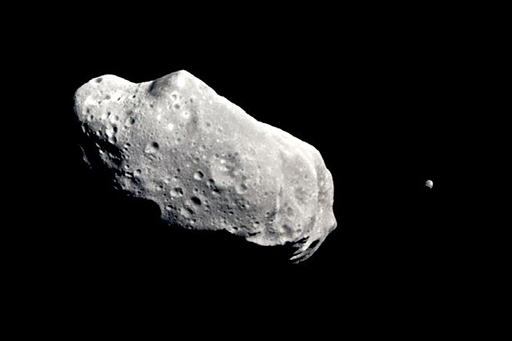2.9 Small bodies can have moons
Many other objects in the Solar System, not just planets, have moons orbiting them. Sometimes, with smaller primary bodies, the moon in orbit around it may be almost the same size.
An example of this phenomenon is the dwarf planet Pluto; its moon, Charon, is so large in relation to Pluto that the centre of mass about which it orbits is not within the body of its primary, but outside, between the two bodies. Pluto and Charon each orbit their common centre of mass every six days in a synchronous rotation, in a form of binary or dual-body system.
Many objects even smaller than Pluto are known to have their own moons. The first moon of an asteroid to be discovered was Dactyl (Figure 32), found to be orbiting the asteroid known as 243 Ida by the Galileo spacecraft that flew by on its way to Jupiter in 1993.

The following link shows images from the November 2023 flyby of the 790 m asteroid Dinikesh by NASA’s Lucy mission that revealed a 220 m moon in orbit about it, subsequently named Selam. Selam looks very much like a ‘contact binary’, that is two separate but similarly-sized objects almost in contact with each other. The smaller of the two halves of Selam comes closer to being ‘a moon of a moon’ than anything else yet discovered. NASA’s Lucy surprises again, observes 1st-ever contact binary orbiting asteroid [Tip: hold Ctrl and click a link to open it in a new tab. (Hide tip)]
